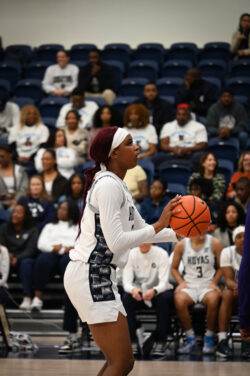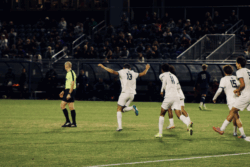Spectators heard an unusual sound late in the second half of Georgetown’s 65-60 loss to Big East foe Seton Hall on Sunday. Clank. The sound of a DaJuan Summers’ three-point attempt thudding off the rim at the Prudential Center in New Jersey.
It was a relieving sound for the myriad Hoya faithful who had traveled to Newark for the game, and it offered a brief interruption from the chants of “Airball, airball, airball!” that had roared through the gym after consecutive three-point attempts by Georgetown guards Jessie Sapp, Austin Freeman, and Chris Wright failed to even draw iron.
To say the Hoyas are in a shooting slump is a gross understatement. They are a combined five of 38 from the perimeter over their last two games—a 75-58 thrashing at the hands of West Virginia was followed by Sunday’s shocking loss at Seton Hall, a game many are ready to call the worst performance by a John Thompson III-coached team since his arrival at Georgetown in 2004.
Sapp, a reliable threat from deep for Georgetown last year (when he made over 40 percent of his attempts), is shooting just 35 percent from behind the arc this season, and only 28 percent since the start of Big East play.
Wright, meanwhile, checks in with even lower numbers: 32 percent for the season, and a dismal 26 percent against conference foes. And this from the guy who just two years ago was crowned three-point shoot-out champion at the McDonald’s High School All-American Game.
More alarming yet may be the fallout of Austin Freeman’s once-potent long-range abilities. He, too, is shooting 32 percent this season, a puzzling drop-off from a respectable 40 percent just one year ago. Reserve guards Jason Clark and Omar Wattad, meanwhile, have combined to hit just 26 percent of their attempts this season.
So what’s the remedy for the Hoyas’ midseason shooting woes? It’s simple. Shoot fewer threes. Excluding the victory against Syracuse, a game in which the Hoyas were unconscious from deep, sinking 12 of 21 attempts, wins this season have not come from behind the arc. Against Connecticut—surely the Hoyas’ best performance this season—they shot an admirable 6-13 from beyond the arc.
The important number there is 13. The Hoyas didn’t have to jack up threes, because John Thompsons III’s hybrid Princeton offense was in full motion, with backdoor-cutters finishing at the rim, Chris Wright utilizing his dribble-drive skills to find open shooters in rhythm, and Greg Monroe taking advantage of his passing skills in the high post as well as his post-up maneuvers down low.
The offense has not been as sharp of late, especially against zone defense. Rather than attack, the Hoyas have been stagnant, passing the ball around the arc, and settling for contested three-point attempts.
They need look no further than their last opponent to see the correct way to break down a zone. Jeremy Hazell was Seton Hall’s savior in the second half on Sunday, scoring 23 points, most of them in the second half, despite missing all 10 of his three-point attempts.
The difference between Hazell and the Hoyas was adjustment. The Seton Hall sophomore missed an astonishing eight threes in the first half. In the second half, he began to attack the Hoyas’ zone, finishing at the rim and repeatedly getting to the foul line. Chris Wright, Austin Freeman, and Jessie Sapp all have the ability to do the same. It’s only a matter of execution.




